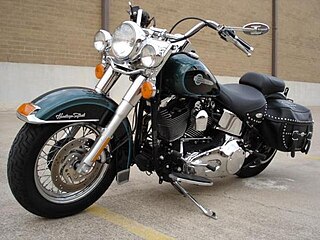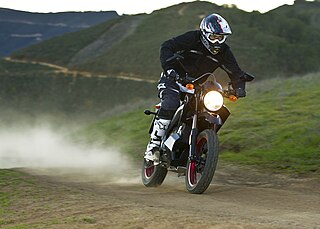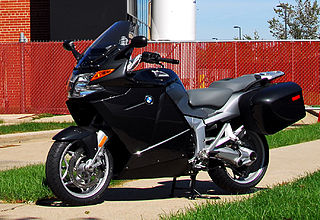 W
WThere are many systems for classifying types of motorcycles, describing how the motorcycles are put to use, or the designer's intent, or some combination of the two. Six main categories are widely recognized: cruiser, sport, touring, standard, dual-purpose, and dirt bike. Sometimes sport touring motorcycles are recognized as a seventh category. Strong lines are sometimes drawn between motorcycles and their smaller cousins, mopeds, scooters, and underbones, but other classification schemes include these as types of motorcycles.
 W
WA cabin motorcycle is a fully or semi-enclosed motorcycle. They first appeared in the 1920s. In parts of Eastern Europe, they are known as dalniks.
 W
WA cruiser is a motorcycle in the style of American machines from the 1930s to the early 1960s, including those made by Harley-Davidson, Indian, Excelsior and Henderson. The riding position usually places the feet forward and the hands up, with the spine erect or leaning back slightly. Typical cruiser engines emphasize easy rideability and shifting, with plenty of low-end torque but not necessarily large amounts of horsepower, traditionally V-twins but inline engines have become more common. Cruisers with greater performance than usual, including more horsepower, stronger brakes and better suspension, are often called power cruisers.
 W
WA custom motorcycle is a motorcycle with stylistic and/or structural changes to the 'standard' mass-produced machine offered by major manufacturers. Custom motorcycles might be unique, or built in limited quantities. While individual motorcyclists have altered the appearance of their machines since the very first days of motorcycling, the first individualized motorcycles specifically labeled 'Custom' appeared in the late 1950s, around the same time as the term was applied to custom cars. In the 1960s, custom artisans like Arlen Ness and Ben Hardy created new styles of custom bikes, the chopper. In the 1990s and early 2000s, very expensive customs such as those built by Orange County Choppers, Jesse James's West Coast Choppers, Roger Goldammer became fashionable status symbols. There are also companies that are bringing back pin striping, such as Kenny Howard and Dean Jeffries from the 1950s, with a continued effort to keep pin striping alive. The choppers of the 1960s and 1970s fit into this category.
 W
WA diesel motorcycle is a motorcycle with a diesel engine. With a traditionally poor power-to-weight ratio, most diesel engines are generally unsuited for use on motorcycles which normally desire low weight, compact size, high RPMs and rapid acceleration. In the 1980s, NATO forces in Europe standardized all their vehicles to operate with diesel fuel. Some forces had fleets of motorcycles and trials were conducted with diesel engines on these. Air-cooled single-cylinder engines built by Lombardini of Italy were used and had some success. This led to some countries re-fitting their bikes with diesel engines.
 W
WElectric motorcycles and scooters are plug-in electric vehicles with two or three wheels. The electricity is stored on board in a rechargeable battery, which drives one or more electric motors. Electric scooters have a step-through frame.
 W
WAn enduro motorcycle is an off-road racing motorcycle used in enduros, which are long-distance cross-country time trial competitions.
 W
WA feet first (FF) motorcycle is a class of motorcycle design that seeks to look at the two-wheeled concept afresh, and create a new form of practical personal transport. The name "feet first" was first used by Royce Creasey and refers to the rider's seating position, with feet ahead in a position, rather than below and astride, as with conventional bikes. As there are other types of motorcycle that have a 'feet forward' position, an alternative term sometimes used is advanced single track vehicle.
 W
WThe term moped originally referred to a type of small motorcycle with both a motorcycle engine and bicycle pedals, generally having a less stringent licensing requirement than full motorcycles or automobiles. The term is now often used to mean a similar vehicle except with no pedals. Mopeds typically travel only a bit faster than bicycles on public roads. Mopeds are distinguished from scooters in that the latter tend to be more powerful and subject to more regulation.
 W
WA motorcycle taxi, or cart bike or bike taxi, is a licensed form of transport in some countries. The taxi typically carries one passenger, who "rides pillion" behind the motorcycle operator. Multiple passengers are common in some countries.
 W
WA scooter or motor scooter has a step-through frame and a platform for the rider's feet. Elements of scooter design were present in some of the earliest motorcycles, and scooters have been made since at least 1914. Scooter development continued in Europe and the United States between the World Wars.
 W
WA sportbike, or sports bike, is a motorcycle optimized for speed, acceleration, braking, and cornering on paved roads, typically at the expense of comfort and fuel economy by comparison with other motorcycles. Soichiro Honda wrote in the owner's manual of the 1959 Honda CB92 Benly Super Sport that, "Primarily, essentials of the motorcycle consists in the speed and the thrill," while Cycle World's Kevin Cameron says that, "A sportbike is a motorcycle whose enjoyment consists mainly from its ability to perform on all types of paved highway – its cornering ability, its handling, its thrilling acceleration and braking power, even its speed."
 W
WA sport touring motorcycle is a type of motorcycle that combines the performance of a sport bike with the long-distance capabilities and comfort of a touring motorcycle.
 W
WA touring motorcycle is a type of motorcycle designed for touring. Although almost any motorcycle can be used for this purpose, manufacturers have developed specific models designed to address the particular needs of these riders. Touring motorcycles commonly have large displacement fairings and windshields that offer a high degree of weather and wind protection, large-capacity fuel tanks for long ranges between fill-ups, engines with a great deal of low-end horsepower, and a more relaxed, upright seating position than sport bikes.
 W
WAn underbone is a type of motorcycle that uses structural tube framing with an overlay of plastic or non-structural body panels and contrasts with monocoque or unibody designs where pressed steel serves both as the vehicle's structure and bodywork. Outside Asia, the term underbone is commonly misunderstood to refer to any lightweight motorcycle that uses the construction type, known colloquially as step-throughs, mopeds or scooters.